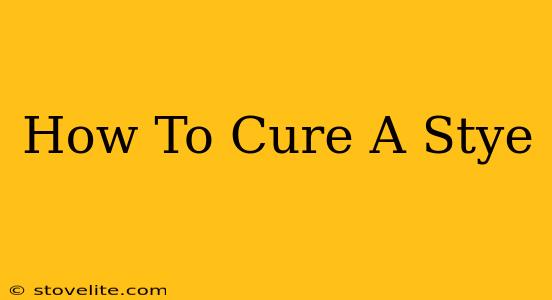A stye, also known as a hordeolum, is a painful, pus-filled bump that develops on the eyelid. It's caused by an infection of the eyelash follicle or oil gland near the eyelid. While usually not serious, a stye can be incredibly irritating and uncomfortable. This comprehensive guide will walk you through effective ways to cure a stye, from home remedies to when to seek professional medical help.
Understanding Styes: Causes and Symptoms
Before we delve into treatment, let's understand what causes a stye and how to identify one. Styes are typically caused by bacteria, most commonly Staphylococcus aureus. Factors that increase your risk include:
- Poor hygiene: Not washing your hands thoroughly before touching your eyes.
- Blepharitis: Chronic inflammation of the eyelids.
- Weakened immune system: Making you more susceptible to infection.
- Contact lens use: Improper cleaning and storage can introduce bacteria.
- Makeup: Using contaminated or expired makeup.
Recognizing a stye is relatively straightforward:
- Painful, red bump: Appearing on the eyelid margin.
- Swelling: Noticeable inflammation around the bump.
- Pus: May develop after a few days.
- Itching: Often precedes the visible bump.
- Crusting: A yellow crust may form on the eyelid.
Home Remedies for Stye Treatment
Many home remedies can help soothe the discomfort and promote healing. However, it's crucial to remember that these are supplemental treatments and not a replacement for professional medical advice if the stye worsens or doesn't improve.
1. Warm Compress: The Most Effective Home Remedy
Applying a warm compress is the cornerstone of stye treatment at home. The heat helps to:
- Improve circulation: Bringing blood flow to the area, aiding the healing process.
- Reduce swelling: Easing pain and discomfort.
- Promote drainage: Helping the pus to drain naturally.
How to apply: Soak a clean washcloth in warm (not hot!) water, wring it out, and gently place it on your closed eyelid for 10-15 minutes, several times a day. Repeat this process regularly for optimal results.
2. Gentle Cleansing
Maintaining good hygiene is essential. Gently clean your eyelids with a mild, hypoallergenic cleanser. Avoid harsh rubbing, as this can worsen the inflammation.
3. Avoid Touching Your Eyes
Resist the urge to touch or rub your eyes, especially if your hands aren't clean. This prevents the spread of bacteria and potential further infection.
4. Proper Makeup Removal
If you wear makeup, ensure you remove it completely before bed, using a gentle makeup remover. Discard any contaminated eye makeup.
When to Seek Medical Attention
While most styes resolve on their own within a week or two with home remedies, you should see a doctor if:
- The stye is severe or doesn't improve: After several days of home treatment.
- You experience significant pain or vision changes: These could indicate a more serious condition.
- The stye recurs frequently: This might suggest an underlying condition requiring treatment.
- You develop multiple styes: This warrants a medical evaluation.
Your doctor might prescribe antibiotic ointments or oral antibiotics to help clear the infection faster. In rare cases, a small surgical procedure might be necessary to drain the stye.
Preventing Future Styes
Prevention is always better than cure. Here are some proactive steps you can take:
- Practice good hand hygiene: Wash your hands frequently, especially before touching your eyes.
- Clean your eyelids regularly: Use a gentle cleanser to remove dirt and debris.
- Avoid sharing makeup and towels: This prevents the spread of bacteria.
- Remove contact lenses before bed: This allows your eyes to breathe and reduces the risk of infection.
- Replace your makeup regularly: Discard old or expired makeup.
By following these tips and seeking appropriate medical attention when needed, you can effectively manage and prevent future styes, keeping your eyes healthy and comfortable. Remember, always consult a healthcare professional for any concerns about your eye health.

